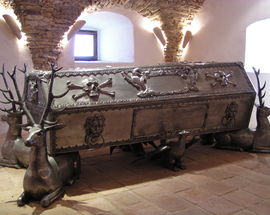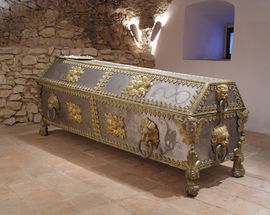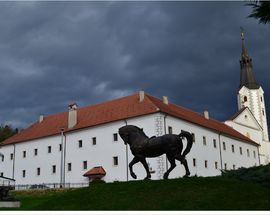Sarcophaguses in Klanjec
01 Apr 2025Here in Croatia, and in particular the largest city in the Sutla valley named Klanjec, is home to two sarcophagi which are carefully kept in the crypt of the side chapel of the great Franciscan Monastery built between 1630 – 1686. Under the auspices of the Franciscan monks, a great amount of sacral treasures and artistic works have also been collected over the centuries.
The sarcophagus-shaped pewter casket of Count Emerik Erdödy sits on the backs of four stags placed at each corner, with two winged eagles in the centre. The front boasts the coat-of-arms of Emerik Erdödy. At each side, lace-like ornamentation surrounds a cartouche in relief, lion's heads with rings at the mouth, and two skulls with crossbones.
Made of tin and lead alloy, it is 218cm in length and the design and iconography is Baroque in nature. It is believed to have been made in Vienna as it was commissioned by Emerik’s nephews. Such sarcophaguses were a sign of aristocracy and were common throughout 17th century ceremonial funerals - the more ornate in appearance, the wealthier the family.
In terms of iconography, the workmanship required skill and imagination as an array of symbols had both earthly and heavenly definition. Skulls and crossbones were a reminder of what is left on this barren earth whereas a stag symbolises pious solitude and the Eucharist. The other sarcophagus made for Duke Sigismund Erdödy includes the faces of four angels on each corner.
The Franciscan monastery, which is home to these sarcophagi, embraces a rich sacral heritage and its library archives depict the grand history of the town which has produced greats such the authors of the first Croatian dictionary Ivan Broz and Franjo Iveković, as well as the great painter Oton Iveković and famous sculptor Antun Augustinčić.
Get a dose of history within a 30 minute drive from Zagreb in the glorious Zagorje countryside. Natural spring spas, wellness, bike tracks, adventure sports, eco villages, and other natural wonders are close in proximity to Klanjec and it is a great option for a day out of the capital!








Comments